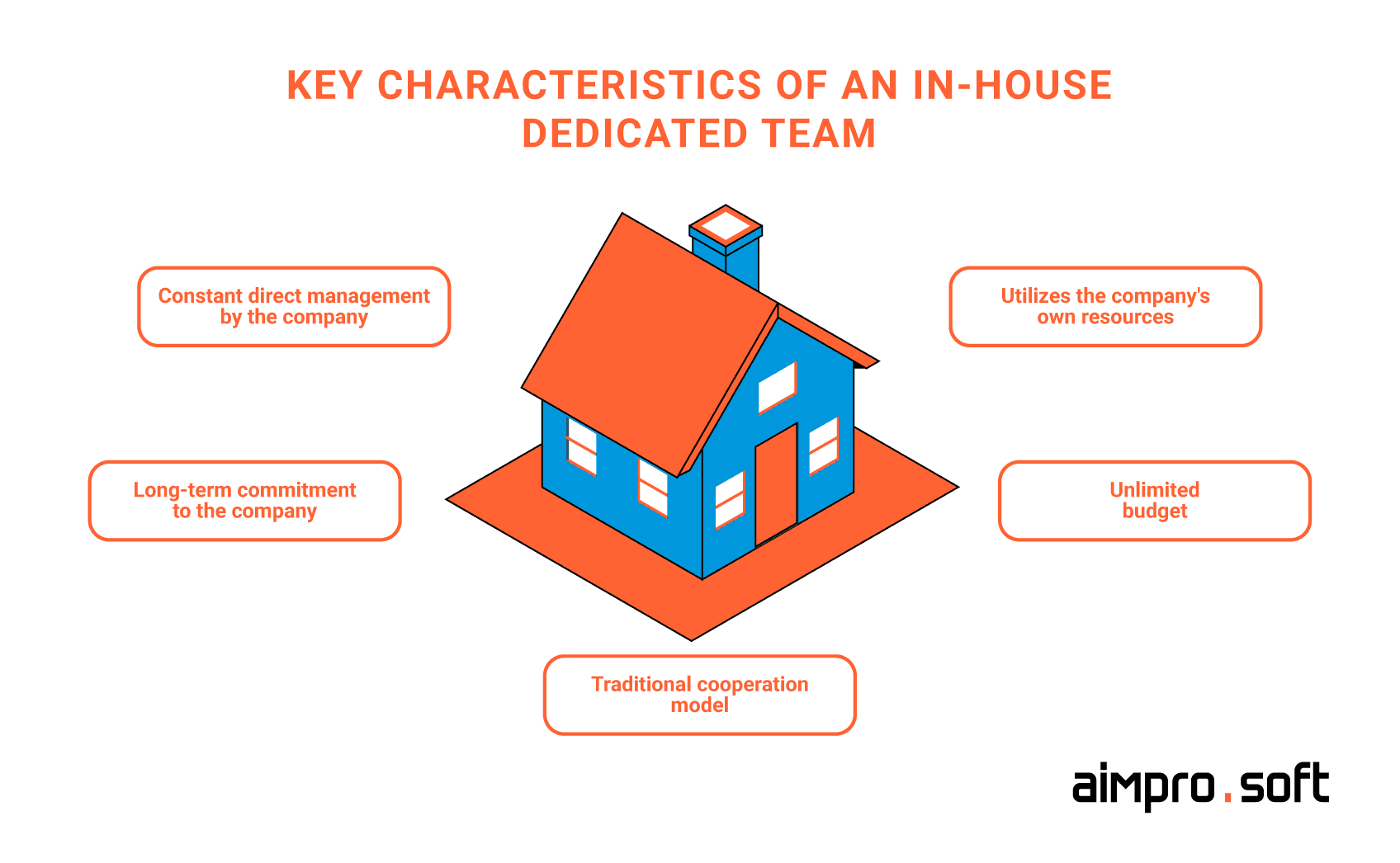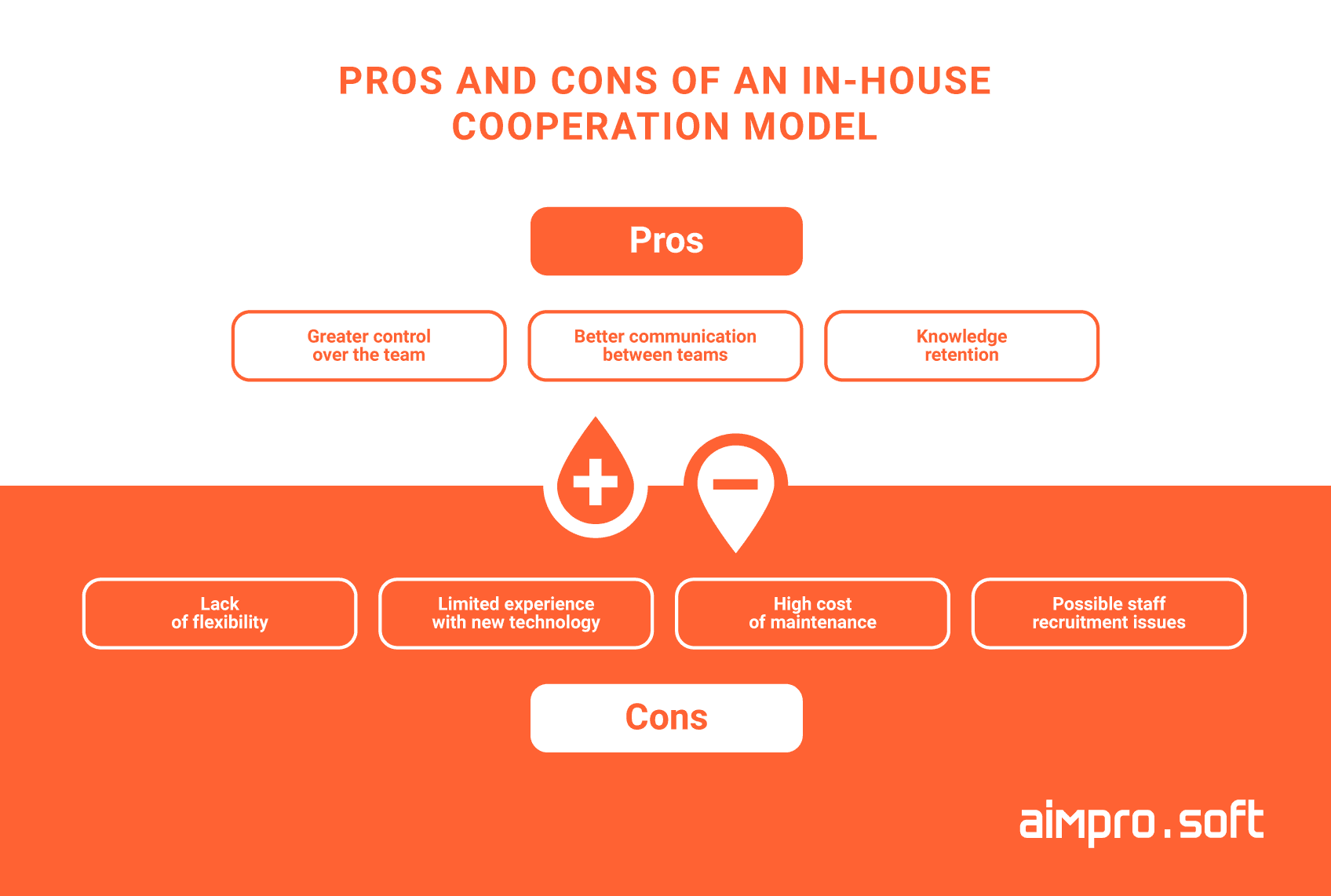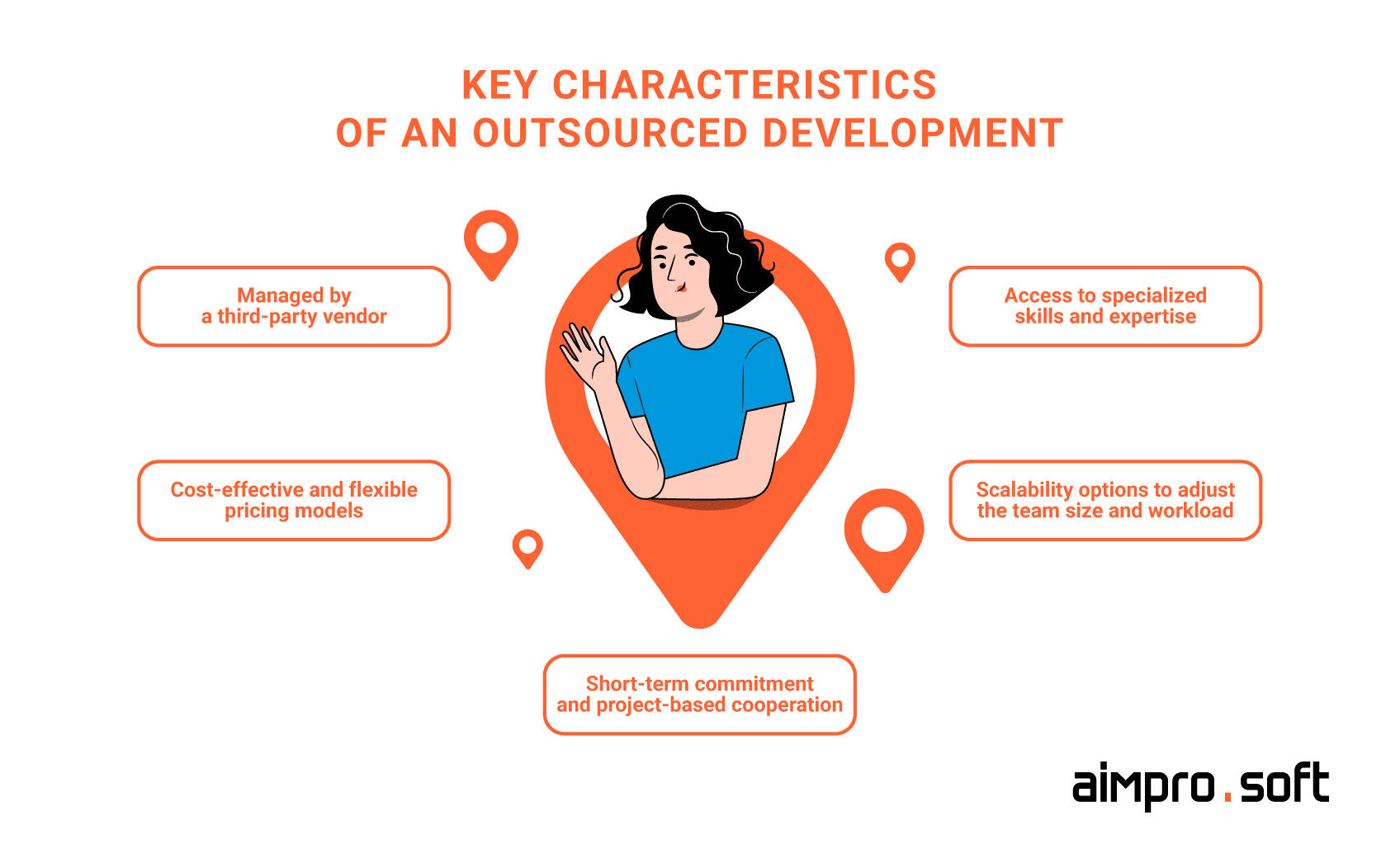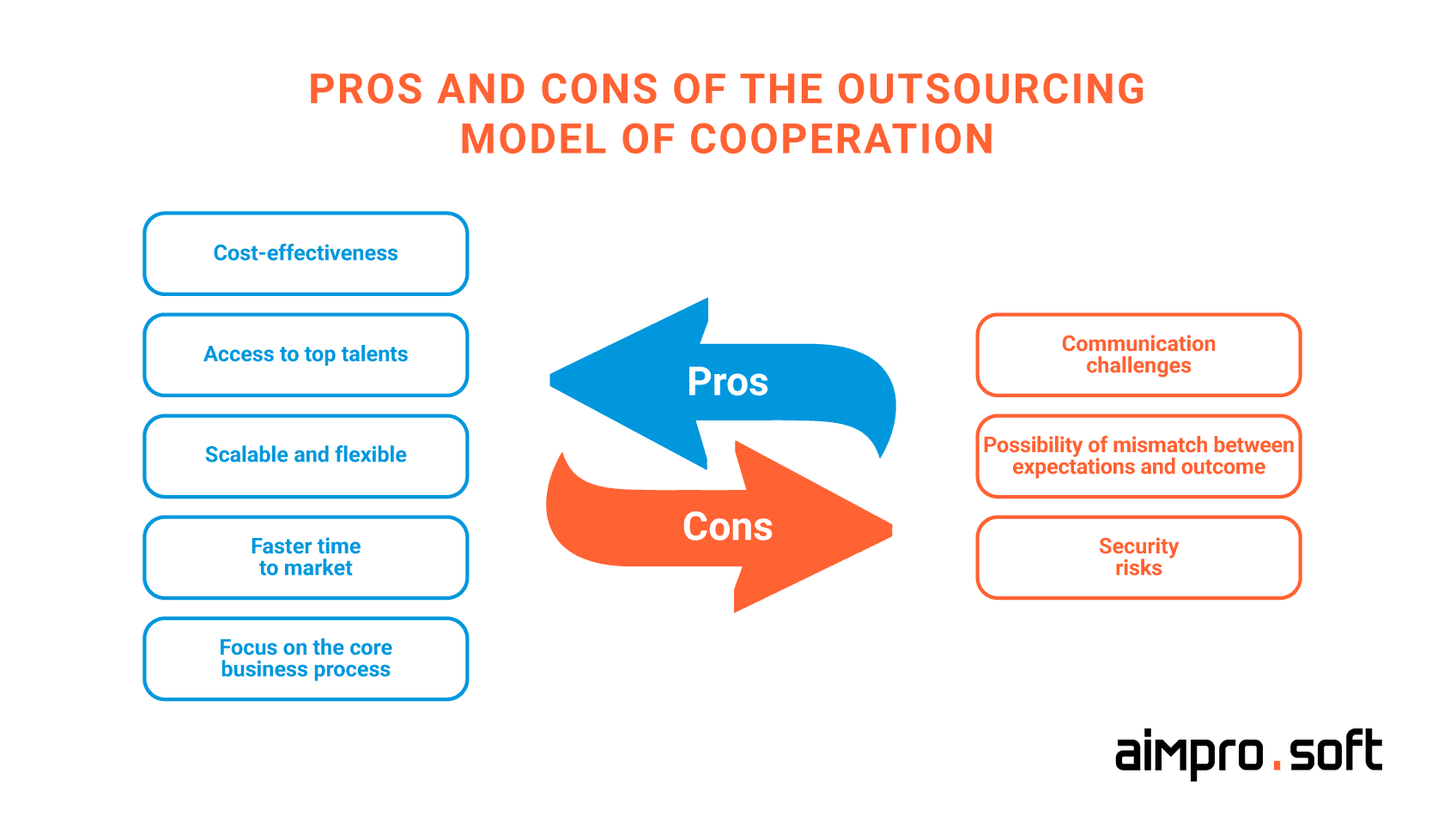Outsourcing VS. In-House Software Development

Key takeaways
- Get more information on how the in house software development process works and the main pros and cons of this model.
- Is outsourcing a more powerful competitor to the in-house model of cooperation? Find out all about the benefits of outsourced development.
- How to choose an outsourcing model for your business? We give answers and tips in our article on how to approach this collaboration model successfully.
Welcome to the world of globalization, where business owners are no longer limited to one path called in house development of software but instead find themselves at a crossroads of options brought by outsourcing. These crossroads are full of different obstacles yet offer a plethora of opportunities. Though choosing a course of action isn’t always simple, it’s a crucial decision that can significantly impact how well your future project turns out. In this article, we’ll look at the pros and cons of in-house vs outsourcing software development teams and advise on choosing the best approach for your business.
What is in-house development?
In-house development is a collaborative model that was established long before the growing popularity of outsourcing. In-house development, also known as internal development, is the process of creating software within a company’s organization using its resources, such as employees and equipment. In-house development teams work exclusively for the company and are usually located in the same office.
You also have the option to create your own team from scratch with in-house development. Based on the experience required to deliver the product, you will fill the vacant roles. Selecting an in-house team is the same as hiring permanent employees. To assemble your own IT team, you will need to go through the recruitment, screening, and onboarding processes.

The main characteristics of a in-house team
In-house development provides companies with more control in the software development process without question, but it requires a significant investment in various resources. In the next section, we look more closely at the pros and cons of in-house development to help you determine whether this approach is right for your business.
In-house software development: pros and cons
Above, we have described how the in-house cooperation model works and its basic principles. Let’s keep comparing in-house vs outsourcing pros and cons. When it comes to software development, many companies face the age-old question: outsource vs in house? While in-house has several advantages, such as greater control and transparency, it also has disadvantages. We will overview every facet of the internal specialist development team in this part to help you decide if this strategy is appropriate for your project.

Pros and cons of in-house development
The advantages of in-house development teams for your business
Greater control over the team
In-house development allows companies to have complete control over the software development process that the team goes through. It implies that programmers can swiftly make changes or updates as required and tailor the software to the client’s current objectives. When communication is real-time, you can tell with absolute certainty if you and your employees speak the same language.
Better communication between teams
Internal development teams share the same workplace as other departments and collaborate closely with them. As a result, they can readily engage with other teams, like marketing and sales, to ensure that the software satisfies the company’s overarching objectives.
Knowledge retention
Employing an in-house team enables businesses to keep the skills and knowledge acquired during the software development process. This data can be utilized to build innovative software products, enhance those that already exist, and share it with other departments to improve the organization’s overall learning process.
The flip side of in-house development teams: disadvantages to consider before assembling them
Lack of flexibility
Because the corporation must oversee and pay for all the resources needed for the project, in-house vs outsourcing development might occasionally limit a company’s flexibility. This covers everything from developer pay and perks to the price of tools, software licenses, office space, and other related expenses. So, inhouse or outsource? In contrast, outsourcing provides the flexibility to increase or decrease the development team depending on project needs. Businesses can easily add or subtract resources as needed without having to worry about the ongoing costs associated with developing in-house.
Limited experience with new technology
As the technology landscape evolves rapidly, it can be difficult for in house versus outsourcing development teams to keep up with the latest trends since the focus on one product development doesn’t require constant expansion of skills and their upgrade. In-house development vs outsourcing, in some cases, team members may not have the necessary expertise to deal with new technologies, which can slow down the development process or lead to poor product quality. In addition, investments in new technologies can be costly and may require significant time and resources to train the team.
High costs
In-house vs outsourcing investing much in hiring, onboarding, training, and retaining is necessary to establish and maintain an internal development team. Companies also need to take into account the price of overhead costs like rent for office space, utilities, and other possible expenditures. These expenses can pile up rapidly for smaller or mid-sized businesses and represent a significant burden.
Staff recruitment issues
When looking for specialized skill sets, it can be challenging and time-consuming to find and hire skilled developers for your internal team, especially in competitive employment markets. Companies may need to invest in recruitment strategies, such as attending job fairs or offering competitive salaries and benefits, to attract and retain top talent. Additionally, training new team members can take time and resources, which can impact productivity and output in the short term.
Wrapping up. Choose to assemble an in-house development team if the following criteria can be applied to your case:
- You need continuous control over the development process
- You don’t have budget constraints
- You are ready to invest in the development and long-term maintenance of the development team
- You aim to preserve team spirit and organized culture
- You have the necessary infrastructure and resources to support your own team
Although companies may better control and adjust SDLC (software development life-cycle) with in-house team, it necessitates a substantial investment in resources and may restrict a company’s exposure to cutting-edge technology. Ultimately, a company’s size, resources, and development requirements will influence whether to choose in house development vs outsourcing.
What is software development outsourcing?
Statistics indicate that spending on IT outsourcing will increase by 22% from 2019 to $519 billion in 2023. This shows that outsourcing is now gaining ground, and more and more companies are relying on this model of cooperation. And businesses, in their turn, namely 78% of the companies who outsource work, view their outsourcing partners positively.
A business may choose to outsource some or all of the tasks involved in its software development process to a third-party vendor. The hired IT provider can offer a variety of services, from project support to full end-to-end development solutions, and is frequently headquartered in another country or area.

Key characteristics of outsourced development
The outsourcing model is based on the idea of using the skills and expertise of external suppliers to reduce costs and increase efficiency and access to a highly specialized workforce. Usually, outsourcing involves several major steps:
Step 1: Selecting an outsourcing provider
The first and most crucial step is to select an outsourcing company that has the knowledge and expertise needed to complete the project and provides an outsourced development team collaboration approach.
Step 2: Identify the scope of the project
Together, the organization and the outsourcing provider define the project’s scope, including its objectives, deadlines, and deliverables.
Step 3: Setting up communication channels
The company and the outsourcing provider should establish channels of consulting and set expectations for regular checks, updates, and feedback.
Step 4: Project development process
The outsourcing service provider works on the project according to a defined scope, using its expertise and resources to deliver high-quality results.
Step 5: Testing
Product testing involves thoroughly checking a developed solution against the required quality and functionality standards. Thorough product testing is necessary to reduce the risk of defects or failures and avoid possible costly delays or loss of revenue.
Step 6: Delivery and ongoing support
The outsourcing company delivers the finished product to the business after the project is finished. Continual assistance might also be given, depending on the terms of the outsourcing contract.
N.B. The stages above may vary depending on the requirements of the project.
Outsourcing software development is a strategic approach that can benefit companies seeking to remain competitive in a rapidly changing technology landscape. By leveraging the skills and expertise of outsourcing service providers, companies gain access to a broader range of talent, technology, and resources, reduce costs, and accelerate time to market.
Nevertheless, outsourcing has challenges, and companies should carefully weigh the pros and cons before partnering with an outsourcing IT vendor. In the next section, we’ll look in detail at outsourcing software development pros and cons so you can make the right choice.
Start your cooperation with a reliable software vendor to make sure the outcome meets your expectations.
CONTACT USThe pros and сons of outsourced development: from сost savings to cutting-edge solutions
As we said earlier, outsourcing software development is a popular approach for many companies looking to expand their capabilities and cut costs. Are you considering in-house software development vs outsourcing? Here are some important points to keep in mind before making a decision between in-house development vs outsourcing. We will now take a closer look at the advantages of outsourcing, as well as the disadvantages that still remain despite the benefits of this collaborative model.

Pros and cons of outsourcing
Pros of outsourced software development
Cost-effectiveness
Cost savings are one of the key advantages of outsourcing software development. Cost is cited by 59% of businesses as the primary reason for outsourcing. Companies can save money by hiring a third-party team rather than recruiting, training, and keeping internal workers. This could save personnel costs and free up resources for the company’s other divisions.
Want to learn more about how outsourcing lowers development costs? And in which regions should you look for a provider to achieve greater savings? Read our article
Access to top talents
Outsourcing may provide you access to a larger pool of qualified IT specialists. Businesses can benefit from the experience of skilled professionals with exposure to the most recent technologies and development techniques by collaborating with an experienced software development company.
Scalable and flexible
Outsourcing gives you the ability to increase or decrease resources as needed. You can add new developers to your team without a tedious and lengthy recruitment process. This can be particularly useful for companies with fluctuating demand or those looking to enter new markets quickly.
Faster time to market
24% of small businesses use outsourcing to boost productivity. Clients do save a significant amount of time, and the development process is accelerated by the fact that the outsourcers already have experience and knowledge of the technologies and tools required in the development process. Additionally, remote development teams are frequently driven to work hard and complete tasks on schedule, offering clients a competitive edge over rivals.
Focusing on core business processes
Software development could distract from concentrating on other key business objectives. When the burden increases, the core business activities suffer, which has a detrimental effect on the organization’s growth. 15% of companies outsource to provide their workers with more free time, so employees will be more focused on the core business goals. Businesses expand rapidly, and outsourcing can significantly aid a company by delegating software development to an outside firm so that they can concentrate on their key competencies.
Cons of outsourcing software development
Communication сhallenges
One potential drawback of outsourcing software development is the risk of communication challenges. It can be difficult to collaborate with a distant team when there are cultural or language obstacles to consider. Regular status updates and efficient channels of communication can reduce this danger.
Problems with quality assurance
Concerns about quality assurance also arise with outsourcing. There could be variations in development standards and procedures when working with a third-party team, which could affect the quality of the finished product. To make sure that the finished product fulfills expectations, it’s crucial to collaborate closely with the outsourced team and create clear quality standards before the start of the development.
Security risks
Working with a remote team can lead to security risks, especially if confidential or sensitive information is involved in the project, your intellectual property may be at risk. It is important to establish strict security protocols like NDA, and simply turning to reliable outsourcing companies who have built a good reputation in the market can reduce these risks as much as possible.
Wrapping up. Choose outsourcing if the following criteria can be applied to your case:
- You want to cut development costs
- There is a lack of resources to assemble and retain an in-house team
- Your company needs to concentrate on its key business competencies and doesn’t want the management of software development activities to divert attention from them
- You want to access a global talent pool and tap into the benefits of a diverse team
- Your project has a deadline; therefore, you must make sure it is finished on time
- By collaborating with a group that has a track record of completing high-quality projects, you want to reduce the risks related to software development
Outsourcing software development can offer many advantages, including cost savings, access to top-class expertise, scalability, and faster time to market. However, it also has potential drawbacks, including communication issues, quality control problems, and security risks that can be solved and overcome with the right approach. But remember, before making a decision about your software development project, it’s essential to weigh the in-house vs outsourcing pros and cons.
How to choose a suitable outsourcing cooperation model?
There are always several important factors to consider when it comes to choosing the right outsourcing model for your software development project. The right choice can make a big difference in terms of cost, quality, and the overall success of the project.
Here are a few criteria you should rely on when making your choice:
Needs, requirements, and initial resources
First of all, it is important to understand your individual requirements and the aims of the project. This includes factors such as budget, timeline, required expertise, and desired level of control over the development process. Once you clearly understand these needs, you can begin to evaluate different outsourcing models and choose the one that best meets your specific requirements.
The level of involvement of the business owner
One important consideration is the level of involvement and control over the development process. Some outsourcing models, such as staff augmentation or dedicated teams, offer a high level of control and collaboration with the development team, while others, such as fixed-price projects, may have less involvement of the business manager in the project.
The geographical location of the supplier and domain expertise
Another important factor to consider is the location and experience of the outsourcing provider. It is important to choose a provider that has experience and expertise in your particular industry and technology stack. The geographical location of the provider should also be considered, as this can affect communication due to the time difference cost of the development.
Price
When choosing an outsourcing provider, a lot of people focus on price. But this can play a nasty trick on you; it is always worth picking not only on the cost of the services but more attention should be paid to quality. The balance between quality of work and development cost can often be seen in the countries of the Eastern European region. For instance, Ukraine has proved to be a reliable destination for outsourcing, with an established IT market, a vast talent pool, and democratic prices for hourly developer rates.
Types of outsourcing models for a more informed vision
We will describe different outsourcing models, which depend on location factors, types of communication, and payment options. You need to know more about outsourcing to make the right choice because there is more to it than meets the eye. For your better understanding, we will look at each model so that you can make an informed and considered decision.
Outsourcing models based on location
Onshore outsourcing
With this outsourcing arrangement, a business assigns its work to a local service provider. This model’s key benefit is that there are no language barriers and that communication and coordination are made easier by the fact that time zones are typically the same and the vendor’s location is close to your company.
Nearshore outsourcing
A business strategy where work is delegated to a third-party service provider in a nearby country or region. With this arrangement, you may save a lot of money while retaining a close geographic closeness, which makes it easier to communicate.
Offshore outsourcing
In offshore outsourcing, a company outsources its work to a third-party service provider in a distant country, often on another continent. The advantage of this model is usually cost savings due to lower prices in such regions and a wide talent pool. More often, people in such outsourcing areas have a lot of experience working remotely, contributing to the development process’s efficiency.
Relational outsourcing models
Staff augmentation model
In this model, a business contract with a third-party service provider to provide teams or individual individuals to work on a project. While you, as a client, retain authority over the project and its management, the service provider is responsible for providing the necessary staff.
Project-based model
Under this strategy, a third-party service provider provides a complete solution to a business’s particular project needs. The provider oversees the project from beginning to end while the company retains control over the result.
Outsourcing pricing models
Fixed-price model
According to the project’s specifications and anticipated workload, the software provider in this model offers a fixed price for a particular project. This technique has the benefit of giving the business an upfront estimate of the project’s overall cost.
Time and materials model
In this business model, the supplier charges the client according to the actual amount of time and resources required to execute the job. The advantage of this model is that it provides more flexibility, enabling adjustments to the project’s needs and scope as necessary. In contrast to the fixed pricing model, the project’s overall cost could be less predictable.
When choosing an outsourcing model, it’s critical to consider the unique requirements of your project and business and the benefits and drawbacks of each outsourcing model while comparing them. By carefully weighing the options and selecting the suitable outsourcing model, you can set your project up for success and achieve your development goals.
Why choose Aimprosoft as your outsourcing partner?
You can always turn to Aimprosoft if you’re truly considering outsourcing for the development of your project. With more than 600 projects completed throughout our more than 18 years of IT market presence, we have established a solid reputation as a trustworthy software provider.
- 80% of our clients come back to us for new projects
- We have experience in more than 20 different industries, including healthcare, real estate, retail, telecommunications, and loT
- We have already served over 200 clients from different parts of the world, including those from the United States, Europe, Canada, and Asia
- We have 350+ IT specialists on board, which means you can build a team specifically for your product
We are a reliable outsourcing provider
Over the company’s history, we have established a strong reputation as a reliable and knowledgeable software provider. We have successfully turned a substantial portion of our clients into loyal ones who have decided to deal with us continuously. We scored 4.7 out of 5 on Clutch based on all customer evaluations.
What do customers think of us as a provider?
Based on numerous opinions and feedback from our clients, we can confirm our reliability. Our clients find that the code provided by our developers is of really high quality, and our customers remain satisfied with the result. Aimprosoft engineers and other specialists are always in touch, courteously answer the client, offer solutions to optimize the development process, are proactive, track time, and provide reports on the completed work in time.
We constantly strive to create the most outstanding caliber results because we cherish our reputation. Also, we are adaptable and always look for the right fit for you. If any of the benefits mentioned above caught your eye and you’re interested in working with an Aimprosoft front-end team, do not hesitate to contact us.
Conclusion
Overall, any organization should carefully consider hiring inhouse development vs outsourcing software development teams. While inhouse development vs outsourcing software has advantages, outsourcing has many benefits as well, including cost-effectiveness, access to talent worldwide, and the capacity to overgrow.
Businesses can successfully accomplish their software development goals by carefully reviewing project requirements, vetting possible outsourcing partners, and choosing the best outsourcing strategy. In the end, outsourcing is still the superior option for the majority of businesses seeking to maintain their competitiveness in today’s fast-paced digital market. And if you opt for outsourcing, you can always contact us; we guarantee that the outcome will meet your expectations precisely.
FAQ
What is the difference between an in-house team and outsourcing?
When a business employs an outside team or organization to work on a project, this is known as outsourcing. In-house development occurs when a business has a couple of developers working on projects inside the company. The location of the development team and whether they work for the company directly or as contractors make the most difference. In-house development gives the business total control over the team and the development process, whereas outsourcing gives it access to resources and knowledge from outside the organization.
Which is better: outsourcing or in-house team?
There is no simple answer to whether in house versus outsourcing development is better. Although outsourcing has numerous benefits, like cost savings and access to a larger talent pool, it also has disadvantages, including difficult communication and the need for careful vendor selection. The choice between inhouse or outsource ultimately comes down to particular requirements. Before making a choice, it is crucial to thoroughly weigh all the possibilities and consider the budget, timeframe, project needs, and available resources.
When is outsourcing better than in-house development?
In several circumstances, outsourcing can be superior to in-house development. For instance, outsourcing to a team with specialized skills and experience can be advantageous if your organization lacks in-house expertise or resources for a particular project. Although outsourcing firms may have cheaper labor costs and more resources available to scale up or down as necessary, outsourcing can also result in cost savings and scalability benefits.
When would in-house development work best?
In-house development vs outsourcing is a common debate among companies looking to develop software or technology solutions. When a business has a well-defined project that calls for a high degree of customization, control, and security, in-house development works best. It is also suitable for businesses that have the necessary resources, expertise, and infrastructure to carry out the project efficiently and cost-effectively.
How to calculate the costs of outsourcing software development vs. bringing it in-house?
Companies should consider several aspects, including the scope of the project, the level of expertise necessary, the resources available, and the anticipated time period, to determine the cost of outsourcing software development compared to in-house development. In the same way, the price of in-house development should account for developer salaries, software and hardware costs, office space, and other overheads. Businesses can determine which solution is more cost-effective by contrasting these expenses.




